The Megan Fox thumbs ‘saga’ continues!
February 9, 2013
 Last december the Megan Fox thumb ‘saga’ continued at The Tonigh Show with Jay Leno, where Megan talked about her thumb insecurities (she has clubbed thumbs)… suggesting that she thinks her weird ‘fat’ thumbs are the result of her mom eating Tuna during her pregnancy of Megan!
Last december the Megan Fox thumb ‘saga’ continued at The Tonigh Show with Jay Leno, where Megan talked about her thumb insecurities (she has clubbed thumbs)… suggesting that she thinks her weird ‘fat’ thumbs are the result of her mom eating Tuna during her pregnancy of Megan!
Megan described:
‘What is weird to me is I was talking to my mom … and she was like, “Oh, I ate tuna every day when I was pregnant with you,” I was wondering if that was what happened to my thumbs. They’re weird and they’re really fat and there’s like a weird knuckle.’
Now that Megan has become a mom herself (in the summer of 2012 Megan wondered if she was maybe birthing a vampire baby like the one from ‘Twilight’), it is heartbreaking to see that she now has the guts to talk about her thumb insecurities. Hopefully, this will inspire other people having this physical anomaly to deal with feeling of shame!
TIP – Megan Fox thumb tribute!
(The episode was featured at VH1 & below you can find the YouTube video featuring Megan Fox interview in december 2012 at The Tonight Show with Jay Leno)
Earlier reports about Megan Fox’ toe tumbs:
• Actress Megan Fox has the clubbed thumb (BDD) – it’s a hereditary cosmetic defect! (2009)
• Megan Fox’ stubby thumbs replaced for Motorola Super Bowl commercial! (2010)
• Megan Fox has Obsessive Compulsive Disorder: what are the associated hand characteristics? (2010)
• Megan Fox’ thumb got Photoshopped in Armani Jeans & Underwear Campaign! (2011)
 Reflexology is known as an alternative medicine involving ‘zone therapy’, which implicates the physical act of applying pressure to the feet, hands, or ears with specific thumb, finger, and hand techniques without the use of oil or lotion. Last year a study from Iran has pointed out that reflexology can produce significant results for women regarding pain intensity and the duration of labor in primiparous (women who are pregnant for the first time).
Reflexology is known as an alternative medicine involving ‘zone therapy’, which implicates the physical act of applying pressure to the feet, hands, or ears with specific thumb, finger, and hand techniques without the use of oil or lotion. Last year a study from Iran has pointed out that reflexology can produce significant results for women regarding pain intensity and the duration of labor in primiparous (women who are pregnant for the first time).
Likewise results for pregnant women had been reported from Iran in 2010.
However… it is important to be aware that there is no consensus among reflexologists on how reflexology is supposed to work; a unifying theme is the idea that areas on the foot correspond to areas of the foot, hand and ear, and that by manipulating these one can improve health through one’s qi.
Therefore it could be very well possible that these findings result from the same ‘human touch’ principles that are being used in haptonomy.
(A few more detailed hand reflexology charts are available in the article: ‘Key-elements of a hand reflexology chart‘)


New Polydactyly Group at Facebook!
November 20, 2012
 Polydactly (extra fingers) is one of the 10 most common pediatric orthopedic conditions, and this condition has been studied as early as the days of Charles Darwin, who suggested that the condition of having more than the usual number of fingers or toes (polydactyly) was an ancient trait, now mostly formant, that occasionally reappears due to some hereditary misstep.
Polydactly (extra fingers) is one of the 10 most common pediatric orthopedic conditions, and this condition has been studied as early as the days of Charles Darwin, who suggested that the condition of having more than the usual number of fingers or toes (polydactyly) was an ancient trait, now mostly formant, that occasionally reappears due to some hereditary misstep.
Basically, there are three polydactyly variants:
A – most common is the variant featured with an extra pinky (see picture above)
B – less common is the variant featured with an extra thumb
C – rare is the variant featured with an extra index finger, middle finger or ring finger
A few (recent) reports about polydactyly:
– UK: The story of a farther + son who were both born with 12 fingers and 12 toes
– INDIA: A 4-year old boy enjoys the attention for his extra fingers
– Bollywood moviestar Hrithik Roshan has 2 thumbs on his right hand

Here’s a fun experiment: stop what you’re doing and use your hands to count to ten. Done? Good. Now remember how you did it, because we’re about to analyze your technique; as it turns out, how you count with your hands may say a lot more about you than you think.
So, how do you count?
Many cultures use some variation of what psychologists call the “closed fist method”, wherein one starts with a closed fist, and begins counting by unfurling the fingers of his or her hand. But the similarities end there.
“The degree of cultural diversity in finger counting… has been grossly underestimated,” write psychologists Andrea Bender and Sieghard Beller in the latest issue of Cognition.
FULL ARTICLE:
The Extra Thumb in the Mole & the Giant Panda is not a real finger: it’s a Sesamoid Bone!
July 16, 2011

A mole has (only) 5 digits + a large sickle shaped sesamoid bone.
Vertebrates usually have five fingers on each hand, but in some specifies – including the Great Panda & the Mole – the hand ‘appears’ to be featured with an extra thumb (polydactly). Earlier this week paleontologists from the University of Zurich have uncovered a new theory about the underlying biological causes that are responsible for the mole’s extra thumb.
The researchers see a connection between the species-specific formation of the extra thumb in the mole and the peculiar “male” genital apparatus of female moles. In many mole species, the females have masculinized genitals and so-called “ovotestes,” i.e. gonads with testicular and ovary tissue instead of normal ovaries. Androgenic steroids are known to influence bone growth, transformation and changes, as well as the transformation of tendons in joints. A high level of maternal testosterone is also thought to be one of the causes of polydactyly in humans.
ABOUT SESAMOID BONES & EXTRA THUMBS!
Anatomically, what ‘appears’ to be extra thumb that is seen in the Mole and the Giant Panda can be described as the result of excessive growth of the so-called sesamoid bones which are typically found in all vertebrates at the end of the thumb metacarpal.
NOTICE: Sesamoid bones are found in locations where a tendon passes over a joint.
In the human hand sesamoid bones are rather small and they act to protect the tendon and to increase its mechanical effect – so they play a key role in the multi-functionality of the human hand, see the picture below.

– Sesamoid bones in the human hand –
However, in some other vertebrate species sesamoid bones have a more explicite function for it’s owner.
E.g. in the mole’s paw the extra thumb is shaped by a sesamoid bone manifesting as a sickle shape which gives the mole a bigger surface for digging.
And in the Giant Panda’s paw the extra thumb is actually shaped by a radial sesamoid larger than the same bone in counterparts such as bears. It is primarily a bony support for the pad above it, allowing the panda’s other digits to grasp bamboo while eating it.

The Giant Panda has 5 digits + a large sesamoid bone.
NOT A REAL FINGER!
These considerations implicate that Moles and Giant Pandas do not really have an extra finger. This is confirmed by the fact that their ‘appearance’ of an extra finger is not featured with other typical characteristics seen in the other fingers – e.g. a nail (claw) & phalanges are missing, and embryology studies have revealed that the extraordinary sesamoid bone in both the Mole and the Panda starts developming at a much later stage compared to the 5 digits that are typically seen in every vertebrate!
MORE ABOUT THE HANDS IN VERTEBRATES:
• The mystery of the five fingers
In the acting and modelling profession, where outward appearance is important, quite a few people with ’clubbed thumbs’ have become successful. Next to Megan Fox (see previous post) being the most well-known example there is a considerable list of models & actresses who have the same thumb abnormality.
Maybe, some might now think that a toe tumb can be ‘sexy’, but the truth is that brachydactyly type d is a common trait in the general population – though the prevalence varies among populations around the world. According the World of Clubbed Thumbs the statistics are: 0.1% of blacks, 0.4% of whites, 1.6% of Jews and 3% of Arabs.
The list of models & actresses with a brachydactyly type d thumb includes (alphabetic order):
• Malin Akerman (Swedish-Canadian actress & model):

• Megan Fox (US actress & model):

–
• Sanaa Lathan (US actress):

–
• Leighton Meester (US actress & singer):

–
• Vittoria Puccini (Italian actress):

–
• Ashley Tesoro (US actress, model & singer):

–
• Anna Walton (UK actress):

NOTICE: A longer list of celebrities who have ‘clubbed thumbs’ is available at Facebook.
–
More hands of actors, models, celebrities & movie stars are available here: http://www.handresearch.com/hands-of-fame.htm
HANDS & EVOLUTION – What if… Cats had Opposable Thumbs?
June 13, 2011
Okay, you probably know that the human opposable thumb plays a significant role in the fact that human kind is ruling the world. But what if cats had opposable thumbs? Would they let us live in peace, or would we be welcoming our new cat overlords?
Cravendale Milk shows us one possible vision of the thumb-catted future in a new ad where thumbcat thugs try to roll humans for cartons of milk.

Scientists simulated the change of the primate hand into the human hand.
Scientists may have solved the mystery of how human hands became nimble enough to make and manipulate stone tools.
The team reports in the journal Evolution that changes in our hands and fingers were a side-effect of changes in the shape of our feet.
 This, they say, shows that the capacity to stand and walk on two feet is intrinsically linked to the emergence of stone tool technology.
This, they say, shows that the capacity to stand and walk on two feet is intrinsically linked to the emergence of stone tool technology.
The scientists used a mathematical model to simulate the changes.
Other researchers, though, have questioned this approach.
Campbell Rolian, a scientist from the University of Calgary in Canada who led the study, said: “This goes back to Darwin’s The Descent of Man.
“[Charles Darwin] was among the first to consider the relationship between stone tool technology and bipedalism.”
“His idea was that they were separate events and they happened sequentially – that bipedalism freed the hand to evolve for other purposes.”
“What we showed was that the changes in the hand and foot are similar developments… and changes in one would have side-effects manifesting in the other.”

Shape-shifting
To study this, Dr Rolian and his colleagues took measurements from the hands and feet of humans and of chimpanzees.
Their aim was to find out how the hands and feet of our more chimp-like ancestors would have evolved.
The researchers’ measurements showed a strong correlation between similar parts of the hand and foot. “So, if you have a long big toe, you tend have a long thumb,” Dr Rolian explained.
“One reason fingers and toes may be so strongly correlated is that they share a similar genetic and developmental ‘blueprint’, and small changes to this blueprint can affect the hand and foot in parallel,” he said.
With this anatomical data, the researchers were able to create their mathematical simulation of evolutionary change.
“We used the mathematical model to simulate the evolutionary pressures on the hands and feet,” Dr Rolian explained.
This model essentially adjusted the shape of the hands or the feet, recreating single, small evolutionary changes to see what effect they had.
By simulating this evolutionary shape-shifting, the team found that changes in the feet caused parallel changes in the hands, especially in the relative proportions of the fingers and toes.
These parallel changes or side-effects, said Dr Rolian, may have been an important evolutionary stem that allowed human ancestors, including Neanderthals, to develop the dexterity for stone tool technology.
 Robin Crompton, professor of anatomy at the UK’s Liverpool University, said the study was very interesting but also raised some questions.
Robin Crompton, professor of anatomy at the UK’s Liverpool University, said the study was very interesting but also raised some questions.
“I am not personally convinced that the foot and hand of chimpanzees are a good model [of human ancestors’ hands and feet] – the foot of the lowland gorilla may be more interesting in this respect,” he told BBC News.
He pointed out that there was a lot more to the functional shape and biomechanics of the human foot than just its proportions.
Paul O’Higgins, professor of anatomy at the Hull York Medical School, UK, said: “The results are quite exciting and will doubtless spur further testing and additional work.”
The hand in Marfan syndrome: thin fingers, hand signs, hypermobility, skin quality & more!
May 24, 2011

Marfan syndrome can be understood as a connective tissue disorder – which relates to the tissue that strengthens the body. The syndrome is usually featured with a tall, slender body with long limbs & extremely long, thin fingers & toes. The most serious complications are the defects of the heart valves and the aorta, which could lead to an aortic rupture (due to too much stress on the aorta), which is usually fatal. But many people who have this disorder are not aware of it! This is partly because Marfan syndrome typically becomes manifest only after the age of 5. But there are many hand signs that have a highly reliable diagnostic value!
Marfan syndrome is featured with many typical hand characteristics, however a combination of two specific hands signs related to a long hand shape (hand signs) & hand motorics (joint hypermobility) is often enough to identify the disorder.
THE STEINBERG SIGN (a):
This test is used for the clinical evaluation of Marfan patients.
Procedure:
Instruct the patient to fold his thumb into the closed fist. This test is positive if the thumb tip extends from palm of hand (see figure a).
THE WALKER-MURDOCH SIGN (b):
This test is used for the evaluation of patients with Marfan syndrome.
Procedure:
Instruct the patient to grip his wrist with his opposite hand. If thumb and fifth finger of the hand overlap with each other, this represents a positive Walker-Murdoch sign (see figure b).

JOINT HYPERMOBILITY
How to check if a person has hypermobility? You can check this easily by doing the 5 tests that are included in the so-called ‘Beighton score‘: see figure 1.
A ‘Beighton score’ of 4 or above usually indicates hypermobility.
And if a person has the Sternberg sign + Walker-Murdoch sign + hypermobility, the chances are above 90% that the person has Marfan syndrome.
The presence of other related hand markers such as: skin quality (hyperextensiblity), a simian crease, extra digital transverse creases, or a high positioned axial triradius provide other significant hand signs which are indicative for a person to have a medical test for Marfan syndrome.

A typical 'Marfan' hand gesture!
HRITHIK ROSHAN – The first Madame Tussauds celebrity with an extraordinary hand: a double thumb tribute!
February 4, 2011

Hrithik Roshan - the Bollywood actor has a double thumb!
On january 22, 2011 Madame Tussauds (London) presented it’s very first celebrity who has an inborn hand condition: the Indian Bollywood actor Hrithik Roshan has a double thumb on his right hand. In medical science this hand abnormality is known as: ‘polydactyly’.
Hrithik Roshan became the fifth Bollywood star to have his wax statue unveiled at the world-famous Madame Tussauds museum in London. Hrithik Roshan spoke during an interview in London, January 20, 2011 after he unveiled his wax double at Madame Tussauds museum there – see the video below (including impressions of his extra thumb).
Just like Megan Fox’s clubbed thumb, Roshan’s double thumb has never really been a handicap for his acting career.
• A photo tribute to Hrithik Roshan’s double thumb
• Modern hand reading: the hands of Hrithik Roshan




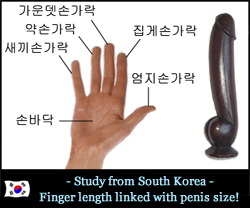 Finger length & penis size linked!
Finger length & penis size linked!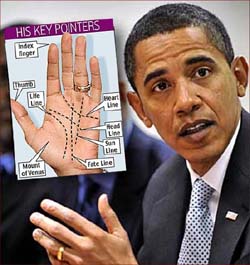 The hands of Barack Obama
The hands of Barack Obama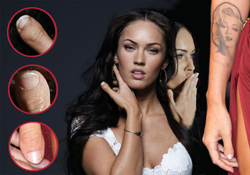 Megan Fox thumbs – TRIBUTE
Megan Fox thumbs – TRIBUTE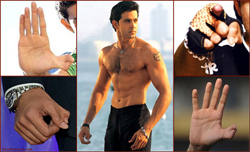 Hrithik Roshan thumbs – TRIBUTE
Hrithik Roshan thumbs – TRIBUTE Hand Reading Research!
Hand Reading Research!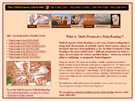 MultiPerspective Palm Reading
MultiPerspective Palm Reading